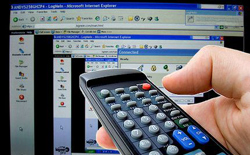
Waiting for the new media

It seems that media web sites around the globe have more or less exhausted their supply of new ideas about presentation of news and related content on the Internet. The form is mostly the same everywhere, including a slight bit of improvisation with regard to background content. The functionality is laid out in a standardized manner, like control levers in a car: although the gear stick may be placed at an unusual position, in the next model or iteration it often goes back to where most people would expect to find it.
Today the differences mostly come down to users' opinions on the colors used (since it is essentially black and white in all places) and arguments about the preference for horizontal or vertical menus.
Willingly or not, the media in Serbia have introduced these standards on their web sites and now most of them have nicely formatted texts enriched by photographs and video content, sidebars, related articles, comments, shared contents, print pages and similar controls.
Therefore, a story has been told and now we expect something new. It is not highly likely that something radically new will appear in the textual presentation of media content, apart from the increasing presence of citizen journalism, but our focus here is on the content delivered by "professional" media outlets.
In the previous years, we have witnessed new advances in the field of audio formats, above all in the play-on-demand form, i.e. the services that allow users to create an arbitrary collection of audio files (play lists) that can be played whenever desired. These are non-linear forms, unlike the traditional radio with scheduled content and time slots for listening.
However, although it seemed highly unlikely that services like imeem or Lala.com would be shut down, it has already happened. Their business model (access to audio content for free or for a small fee) had no chance of success: exponential growth of the number of users and their preferences could not be supported by advertising used by these services. They quickly suffered losses and were absorbed by Rupert Murdoch (News Corp), in the case of imeem, and Steve Jobs (Apple), in the case of Lala. Spotify.com has achieved more success and succeeded in attracting mobile telephony users.
It is clear that future online business models will require more creativity than ever when it comes to traditional advertising models and free content. Like all users of the Internet, I hope that the latter will somehow survive. At the first glance it may seem that the traditional media web sites have managed to avoid such fate since most of the content is still freely available, but the future is uncertain.
At the moment, the area that is not so widely exploited, especially in Serbia, is the multimedia content served in the living room – the space for relaxation and entertainment. By this we mean mostly the content that is delivered to users via TV sets and Hi-Fi equipment, not via PCs or notebook computers. Optionally, gadget enthusiasts may use a nettop computer like Zotac MAG (costing slightly more than 200 EUR) for such needs.
This area is related to Internet's entry into mainstream usage, like for example how TV is used today. Users can sit in a chair and manipulate their remotes to select the content they wish to watch, the difference being that they are not limited by their cable provider anymore. This scenario certainly offers much more than today's IPTV.
Imagine a choice of thousands if not millions of sources of multimedia content around the globe. Of course, you will not have to surf all these channels – simply create a list of your preferred destinations, to be served on demand. For example, you can choose a TV show offered by B92, take another from the Animal Planet, the third from the MTV, add a film from your local network (the PC in the living room) etc. Of course, those who do not like to choose will still have a possibility of being served "linearly", but the available choice will be much wider.
The main feature of this scenario is the ability to achieve this on your own TV set and in the comfort of your living room, which has previously been the advantage of the traditional television.
During this year's CeBIT in Hannover, we have had a chance to witness the expansion of this trend: most of the manufacturers from China and neighboring countries offered a similar device aiming to bringing the Internet to your TV set with a friendly user interface (the so-called 10 foot user interface).
On the other side, most of the major producers of TV sets already offer models with integrated media centers and the ability to directly connect to web applications. The current landscape looks increasingly like the app-store model made famous by Apple, for example. Of course, speaking of Apple, their Apple TV has been around for several years, but in this case we have in mind something more like Boxee.tv service, which we can highly recommend.
Since we have already mentioned the car analogy at the beginning of this text, we can end it in the same way. Innovations in traditional online media (traditional web sites powered by advertising) are akin to modernizing the cars that consume unsustainable fossil fuels. The future looks radically different. Unfortunately, it is much faster being realized in the virtual than in the real world.
Dejan Restak
MC Newsletter, May 21, 2010
 |
| The content of this article does not necessarily reflect the view of the Media Center. The author bear full responsibility for the content of the text. |




